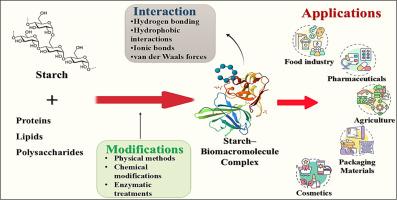Starch–biomacromolecule complexes: A comprehensive review of interactions, functional materials, and applications in food, pharma, and packaging
IF 6.5
Q1 CHEMISTRY, APPLIED
Carbohydrate Polymer Technologies and Applications
Pub Date : 2025-09-01
DOI:10.1016/j.carpta.2025.101001
引用次数: 0
Abstract
Starch, a plentiful and biodegradable polysaccharide, has become a flexible platform material due to its renewability, affordability, and ability to improve functionality by complexing with biomacromolecules. Even with its inherent benefits, native starch faces drawbacks like low mechanical strength, high moisture susceptibility, and limited thermal stability, which impede its effectiveness in challenging applications. To address these limitations, starch is progressively blended with proteins, lipids, and polysaccharides, resulting in starch-biomacromolecule complexes (SBCs) that exhibit altered physicochemical and functional characteristics. These interactions-spanning hydrogen bonding, hydrophobic association, covalent crosslinking, and thermodynamic stabilization-enhance viscosity, gelation behavior, structural stability, and barrier properties.
This analysis methodically explores the molecular processes involved in starch-biomacromolecule interactions, emphasizing how these complexes can be designed to customize functional attributes. It also consolidates recent progress in the use of SBCs in food systems (texture alteration, nutritional improvement, and preservation), pharmaceuticals (medicine delivery, controlled release, and biomedical frameworks), and packaging (biodegradable films, barrier layers, and active systems). New strategies like nano structuring, bioactive encapsulation, and hybrid composites are also thoroughly examined regarding their capability to tackle processing difficulties, environmental pressures, and scalability concerns. This article highlights the significance of SBCs as next-generation biomaterials for sustainable innovations in the food, health, and packaging sectors by connecting essential insights with technological applications.

淀粉-生物大分子复合物:相互作用、功能材料及其在食品、制药和包装中的应用的综合综述
淀粉是一种丰富的可生物降解的多糖,由于其可再生性、可负担性以及通过与生物大分子络合提高功能的能力,已成为一种柔性平台材料。即使具有其固有的优点,天然淀粉也面临着机械强度低、易受潮性高和热稳定性有限等缺点,这些缺点阻碍了其在具有挑战性的应用中的有效性。为了解决这些限制,淀粉逐渐与蛋白质、脂质和多糖混合,形成淀粉-生物大分子复合物(sbc),其物理化学和功能特征发生了改变。这些相互作用——跨越氢键、疏水缔合、共价交联和热力学稳定性——增强了粘度、凝胶行为、结构稳定性和屏障性能。该分析系统地探讨了淀粉-生物大分子相互作用的分子过程,强调了如何设计这些复合物来定制功能属性。它还整合了sbc在食品系统(质地改变、营养改善和保存)、药品(药物输送、控释和生物医学框架)和包装(可生物降解薄膜、阻隔层和活性系统)中使用的最新进展。纳米结构、生物活性封装和混合复合材料等新策略也被彻底研究,以解决处理困难、环境压力和可扩展性问题。本文通过将基本见解与技术应用相结合,强调了sbc作为下一代生物材料在食品、健康和包装领域可持续创新的重要性。
本文章由计算机程序翻译,如有差异,请以英文原文为准。
求助全文
约1分钟内获得全文
求助全文

 求助内容:
求助内容: 应助结果提醒方式:
应助结果提醒方式:


